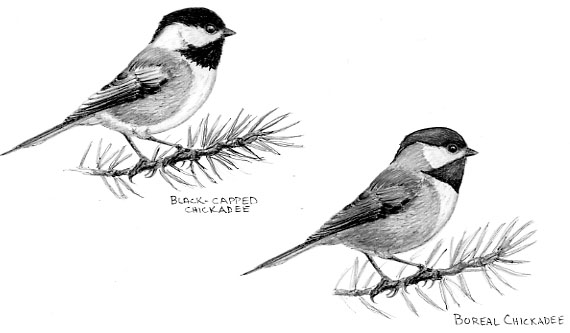
Dear Bird Folks,
Please find the attached photo of a bird eating from my feeder. I know the bird is a chickadee but it looks different to me. Could it be a Boreal Chickadee?
– Art, Poughkeepsie, NY
I feel bad for you, Art,
You live in a very tough town. I don’t mean gangster tough; I’m talking about spelling tough. I live in the town of Orleans. It’s a simple town with a simpler name. Yet, anytime I try to tell someone my address over the phone I have to spell Orleans at least twice before I start yelling: “It’s ‘Orleans,’ like ‘New Orleans,’ only hold the ‘New!'” Once I say “New Orleans” they get it and we’re all friends again. I can’t imagine what you must have to go through. The next time you have to spell the name of your town just yell: “It’s ‘Poughkeepsie,’ like ‘New Poughkeepsie,’ only hold the ‘New.'” I’ll bet it works. Either that or the person on the other end of the phone will say: “You don’t happen to know a guy from Orleans, do you?” If that happens hang up. Never tell anybody you know me. It will be better for you that way.
Now that we have that out of the way, you’ll be happy learn that the bird in your photo definitely could be a Boreal Chickadee. Yes, it could be, but it’s not. The bird at your feeder is our old pal the Black-capped Chickadee. Do you know how I can tell? Your bird has a black cap. That field mark alone closes the deal. The Boreal Chickadee’s cap is kind of brown, not jet-black like say, the cap of the Black-capped Chickadee. Of the seven chickadee species found in the U.S., only two others have black caps. One is the Carolina Chickadee, but since New Poughkeepsie is in New York and not in Carolina, it’s not that bird. The other is the Mexican Chickadee, of the Southwest, which also has a definite black cap, but it can be hard to see since it’s usually hidden under a tiny sombrero.
As you might have guessed from their name, Boreal Chickadees are birds of the far north. Most of them live in the great spruce forests of Canada, but a few exist in the higher terrain of the U.S. states that border Canada, including New York. Over the years the Boreal Chickadee has been given a variety of other names including: “Acadian Chickadee,” “Fillady,” “Chick Chick” and “Tom-tit.” (I’ll bet nobody named Tom voted in favor of that last one.) When compared to the Black-capped Chickadee, the boreal has richer brown on the sides (yes, black-caps have brown on their sides, too, but somehow no one notices it). The cap of the boreal isn’t solid brown, but it’s washed in brown, like a dye job that didn’t work out. While the Boreal Chickadee does give the signature “chick-a-dee” call, which is required to be in the Chickadee Club, its voice is raspier than the black-cap’s. It sounds like a bird that desperately needs a cup of tea and honey or a box of Sucrets.
What’s missing from the Boreal Chickadee’s vocal array is the notorious chickadee whistle song. I say “notorious” because I’ve never had a bird sound cause so much confusion. When some people hear the whistle song of the Black-capped chickadee (which sounds like “fee-bee-e”), they assume they are hearing a phoebe. Makes sense, even if it is wrong. But it doesn’t end there. Tons of other folks have their own interpretations of this sound. I’ve heard everything from “bee-quiet” to “Jean-did-it” to “cheese-burger.” I think that last one was started by some marketing person at McDonald’s. Being a non-meat eater I tried to start the rumor that the birds were really saying “to-fu” but it never caught on. The Boreal Chickadees have decided to avoid the controversy altogether by not ever singing that phrase.
In my mind, the Black-capped Chickadee is the cuter of the two birds. However, the Boreal Chickadee is probably a bit tougher when it comes dealing with extreme cold. A researcher reported finding dead black-caps after a winter’s night had dipped to fifty below zero, but found no dead boreals. (Fifty below!!! Maybe the birds are really saying, “We’re freez-ing.”) In order to survive in such an unforgiving environment the birds must have plenty of food. Each fall they gather and stash as much food as they can find. By using spit and spider web thread the clever birds attach extra insects and seeds to the undersides of tree branches. Why the “undersides” you ask? Because in the winter snow typically covers the topsides of the branches. I can see you wouldn’t last too many nights outside at fifty below. You people from New Poughkeepsie are so soft.
I wasn’t kidding, Art, when I said that the bird at your feeder “could be” a boreal. Every once in a while a food shortage will force these birds to head south. In December of 2005 a Boreal Chickadee spent several days at a suet feeder in Orange, MA and I don’t think that’s very far from you. So keep that camera handy and one day you may be e-mailing me pictures of Tom-tit. If you do that you’d better send them late at night, after my kids go to bed.